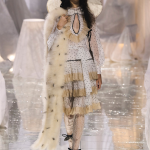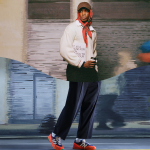
Within the past few weeks , the local conversation surrounding the depths and definitions of masculinity has been quite abuzz. Following the performances of artist Achille Lauro at the Italian music festival Sanremo who shook the nation with his flamboyant Gucci ensembles and heartfelt quotes on his views of masculinity, many have since been called to question the integrants of mainstream masculinity within the Italian society.
The topic has been brought to the frontlines and although many have been treating it as a new form of masculinity, yet the reality is that the very wide spectrum of masculinity is an age old concept which Italy seems to have only just been discovering.
On an international scale, the movement of masculinity’s broad spectrum is way ahead of the game with celebrities like Billy Porter, Harry Styles & Ezra Miller being champions for several different representations. In Italy however, the leading forces have been brands like Gucci, Zegna and more recently artists Achille Lauro as well as Ghali. This is why for the latest nss magazine’s Digital Cover we have chosen to explore the topic with an editorial shot by photographer Boris Ovini and an op-ed discussing the subject and it’s struggle to break into the bubble of mainstream Italian culture with Italian Clinical Psychologist and gender studies expert Guido Giovanardi.
Credits
Photography Boris Ovini
Photographer's assistant Marco Pistolesi
Styling Riccardo Maria Chiacchio
Casting Director Sabrina Mostrangelo
Hair Daniella Magginetti @closeupmilano
Makeup Vanessa Geraci
Creative Direction nss magazine
Creative Producer Jordan Anderson
Production Coordinator Ali Kiblawi
Production nss factory
The New Italian Masculinity - nss magazine Digital Cover N.02
The third chapter of our digital cover series is an exploration of what it means to be masculine on italian terms
February 27th, 2020
Original traces of fluid masculinity stretch as far back as the 1970’s and ‘80s which was a prime time for the exploration of different manifestations and interpretations of art. It was when figures like Boy George, Prince and David Bowie created a movement out of expressing themselves and their music through forms of androgynous fashion. The visual experience of their performances was just as interesting and gratifying as the music itself.
Locally, around this period, Italy also saw its first androgynous pop star Renato Zero, who was a part of the glam rock movement and who often wore colourful makeup and flamboyant clothing. They all feminised themselves in different ways, which in turn made it cool to adore women. For men, they also made us aware of our own male body.
This influenced an entire generation’s sense of fashion. Even straight men began sporting David Bowie lightning bolts, silvery moons on their brows and mullet hairstyle to complete their punk rock look. Somewhere in the 90’s the trend turned into a more grunge/emo effect with artists like Kurt Cobain and in the mid 2000’s this sentiment seems to have gotten lost. It then re-manifested itself in hip-hop music during the 2010’s when rappers and hip-hop artists became inspired by these icons which form what some now known as the new masculinity.
However in order to understand the impact of this “new masculinity” which has arisen one must first acknowledge it’s flip-side, which is what many know as toxic masculinity.
In psychology and social sciences the term toxic masculinity is in reference to traditional cultural masculine behaviours and standards that can be considered harmful to other men, women and society on a whole. It’s not a term in allusion only to being male, but more so refers to the adherence of a set of stereotypical rules that define men as the dominant figures in society which is often accompanied by homophobia and misogyny. This type of masculinity becomes toxic especially when they promote anger and violence against women and stigmatize or limit the emotions in boys and men. It is the need to aggressively compete and dominate others and is the avoidance and at times condemnation of any forms of femininity associated with the male experience.
The evolution of this new masculinity was formed in opposition as a sort of cure to the toxic one. It was the defiance of all the traditional regulations to masculinity and an exploration in blurring traditional gender roles . This new masculinity is one that not only embraces and promotes emotional well being among males but also welcomes the freedom to express traditionally feminine aspects and behaviours. Which is why when a male figure, especially one who has been known as heterosexual asserts himself in a feminine light such as wearing a skirt, or a dress or even wearing makeup, it is seen as a denounciation of these desctructive, venomous traditional traits because in practicality, the antidote of toxic masculinity is of course femininity.
This had a huge impact in the world of hip hop/rap music mainly because it is a musical genre notorious for lyrics homophobic lyrics and behaviour and furthermore dominated by racial minorities where homophobia runs rampant.
This refers to things such as rapper Eminem defending his use of the word faggot: “faggot' to me doesn't necessarily mean gay people. 'Faggot' to me just means... taking away your manhood. You're a sissy, you're a coward," and other artists who continuously used the phrase “no homo” in all their lyrics. This was a major sign of toxic masculinity as it was the epitome of heterosexism i.e. the prejudice against homosexuals on the assumption that heterosexuality is the normal sexual orientation.
So when other rappers and musicians in the same industry like Young Thug, Jaden Smith, Tyler The Creator and Pharrel Williams began pushing the boundaries of masculinity through fashion, it was a sign of something monumental within the industry because it meant disassociating themselves from this stereotype. From Young Thug wearing an Alessandro Trincone dress on his 2016 album cover to Jaden Smith created buzz for posing in skirts and dresses for magazine covers. It was a sort of movement that included expressing one’s feminine side which was seen as a symbol of vulnerability, humility and a certain type of security in one’s sexuality and identity.
In GQ’s 2019 New Masculinity issue, Pharrel Williams apologized and distanced himself from his 2013 hit single Blurred Lines because of its sexually predatory undertones .
“I realised that we live in a chauvinist culture in our country. I hadn’t realised that before and didn’t realise some of my songs catered to that. So that blew my mind,” he explained. Him and many others distancing themselves and denouncing this toxic type of behaviour was an important step in moving towards a more culturally sensitive mindset especially following the #METOO movement where aspects of toxic masculinity were being exposed.
Many acknowledged this wave as a new form of masculinity. The ability to proudly own one’s feminine aspects paired with the blurring of gender roles by the LGBTQ+ community influenced fashion’s revolution in the western world. According to a Williams Institute study from 2016, 1.4 million adults in the US don’t identify with their birth gender, offering further evidence that many people – particularly those belonging to Gen Z – no longer feel constrained by binary notions of gender.
“I feel like people are kind of confused about gender norms. I feel like people don’t really get it. I’m not saying that I get it, I’m just saying that I’ve never seen any distinction. I don’t see man clothes and woman clothes, I just see scared people and comfortable people,” explained Jaden Smith in an interview with British GQ style.
In Italy however, the wave of gender fluidity is moving a bit slower. This is reflected in the way people think and act towards the mixing of genders throughout fashion.
A few weeks ago during Ghali’s fashion week errands, the singer chose to dress himself in a pink coat for the Gucci show. Not long after posting images, the singer received a wave of homophobic backlash on instagram from followers who were not in agreement with his feminine look.
A few weeks after, artist Achille Lauro debuted at Sanremo music festival with a series of flamboyant Gucci looks and his performance of the hit song “Gli uomini non cambiano mai” by Mia Martini. Following this the artist published some notes on his bleak experience with the construct of traditional masculinity and homophobia in Italy.
The general feedback was a mixture of positivity as well as negativity but it calls for concern as to why Italy is so behind in the evolution of its collective consciousness. According to Dr Guido Giovanardi, a research doctor and psychotherapist that deals with gender identity in the department of dynamic and clinical psychology of the La Sapienza University of Rome, Italy’s ties to traditional masculinity runs deep.
“ I think in Italy we have cultural roots that at times appear to be more Mediterranean than European, we align more with certain cultures like North Africa , Turkey or Greece whose gender roles are quite strong and consolidated as a result of our history. If you visit anywhere in the South of Italy today, you’ll witness a wedding that seems like a wedding from the 50’s. We’ve just not had that immersive process of democratization which a country like Spain was able to have. Of course it also has to do with the presence of the Vatican and the importance of catholic education in the school as Christianity helps enforce these gender roles. Little by little things seem to be changing but very slowly. ”
Thankfully however, Italian fashion brands don’t follow the pace of things on a local basis but follow international standards in order to remain relevant, which is why brands like Gucci, Zegna and more recently Fendi have been the local leading forces behind a more open minded approach of masculinity and gender in general, similar to one we once praised in the 70’s. For Gucci’s last menswear show was aimed at destroying the concept of toxic masculinity , designer Alessandro Michele created a collection that combats western society’s ideal of macho virility.
“Toxic masculinity, in fact, nourishes abuse, violence and sexism. … it produces oppressors and victims at the same time.It seems necessary to suggest a desertion, away from patriarchal plans and uniforms. It’s time to celebrate a man who is free to practice self-determination, without social constraints, without authoritarian sanctions, without suffocating stereotypes, ” read their FW20 press release.
Zegna on the other hand, having long made clothes for the modern man, recently partnered with one of Italy’s most prominent humanitarian organizations CESVI to promote positive behavioural changes, which began with a campaign questioning What Makes a Man. Rather than explaining what masculinity is to them, it’s aim is more to facilitate discussion in exploring different manifestations and interpretations of masculinity. But does fashion really have such a power to usher a nation into a new way of thinking ?
“I believe fashion brands can surely contribute in influencing these types of changes. For example ,the entire experience of Achille Lauro at the Sanremo festival, under a great level of homophobia and also sexism with the recent comments of Amadeus . He was able to open a conversation on what it means to be masculine, regardless of whether the feedback was good or bad, the point was the conversation was opened, and his dressing played a symbolic role in opening that door,” explained Dr Giovanardi.
These gestures along with Generation Z being one of the most open in their views of gender norms, are the main factors of what will speed up the pace of things locally.
"I’m quite hopeful for things changing with this generation. In school , homophobic behaviour is stigmatized and shunned for the most part. One of the main psychological factors of protection against bullying is the possibility to have allies, to have people and friends who support and protect you, and I believe that this community of support has been growing dramatically , thanks to new scholastic material, cultural aspects and tv series that propose positive images. This generation of teenagers are also very open, not only to sexuality, but they’re also experimenting with gender fluidity and neutrality ,they’re throwing away all the labels and opening a powerful space where healthy experimentation is taking place from a point of view of gender, ” concluded Dr Giovanardi.
Which means all things considered, locally, although things are moving slowly, they are nonetheless moving towards the better and even though Gen Z in the US might be further ahead in the acceptance and normalization of the blurring of gender roles than Gen Z in Italy, the important thing is that they are both just as open-minded. The mere fact that we are having this conversation in itself is a sign that the floor has officially been opened for positive change.






















































































